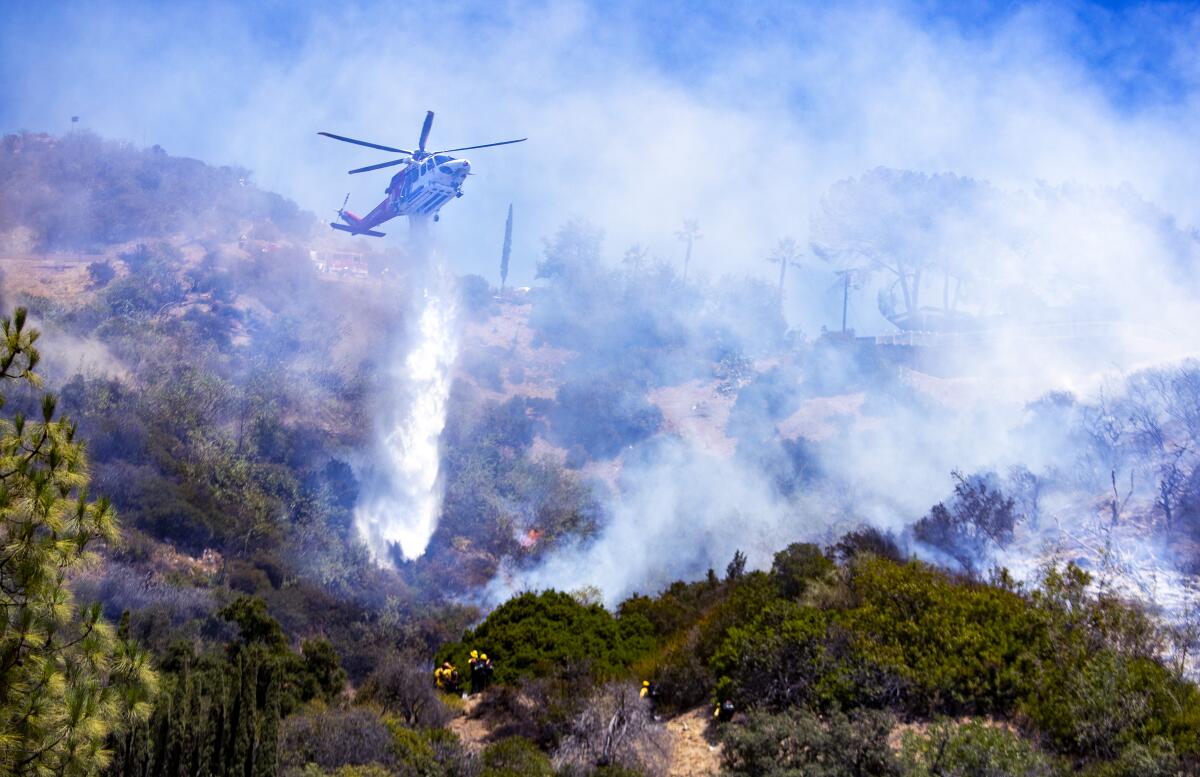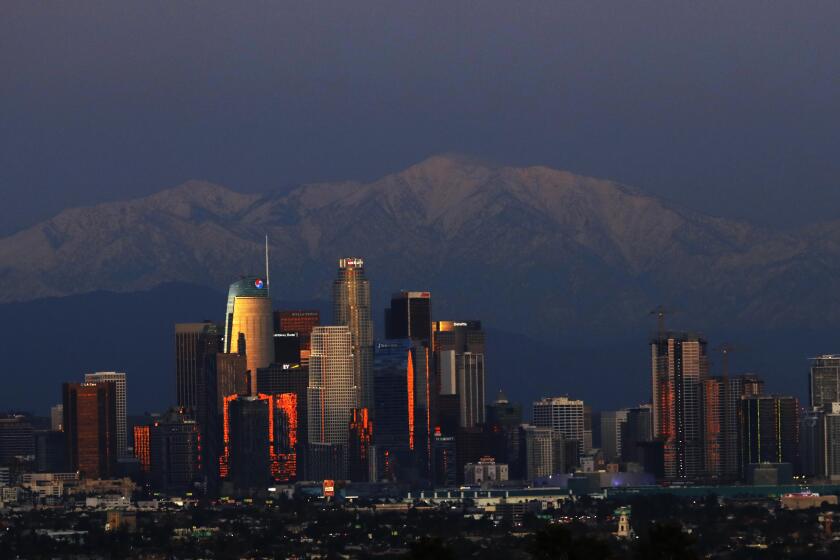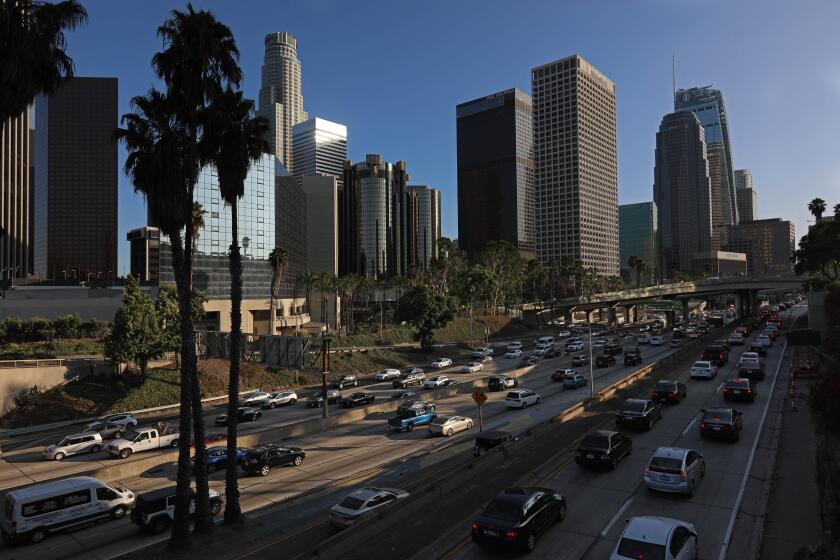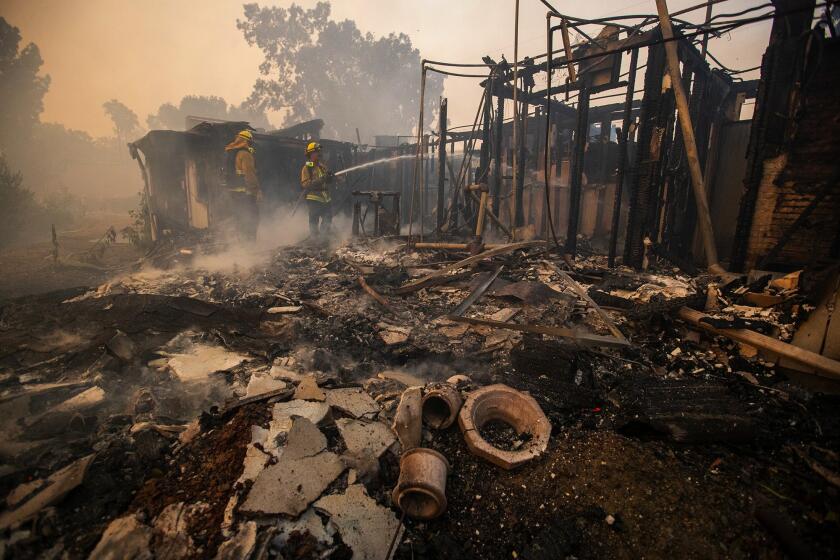House-hunting? How to learn the wildfire risk of every L.A. neighborhood

- Share via
This summer, we began asking readers to submit their most pressing business-related questions about Los Angeles and California.
Then we put the questions to a vote, allowing readers to decide which question we would answer in story form.
Our latest winner was submitted by Shawn Spencer, a human resources worker in Massachusetts: “If you’re concerned about wildfires, which L.A. neighborhoods should you avoid living in?”
“I am fascinated with Los Angeles, but for someone like me who does not live there, it can be challenging to understand the city,” Spencer explained in the submission form. “Is there a rule of thumb for people who are worried about wildfires, such as ‘do not live in a canyon, do not live far north of Sunset Boulevard, etc.’?”
“My assumption is that you don’t want to be in the hills,” Spencer said in a later phone call.
Turns out, there are a variety of ways to assess a neighborhood or individual home’s risk of wildfires — and plenty of ways to help mitigate the danger.
Whatever’s puzzling you about life in L.A. and California, we want to hear about it.
Use maps
If you’re curious about a home’s wildfire risk, look up the address using one of a few different maps available to the public.
Los Angeles County has an interactive map of fire hazard zones.
A quick glance at the map confirms Spencer’s hunch about hilly areas — large swaths of Malibu, Pacific Palisades, Bel-Air and the Hollywood Hills have a “very high” hazard class.
The same holds true for neighborhoods around Angeles National Forest, the Verdugos, as well as smaller pockets in Playa del Rey and Ladera Heights.
The California Public Utilities Commission and the California Department of Forestry and Fire Protection also offer maps that people can use to search for their address. In addition, residents can check their property’s brush clearance status on the Los Angeles Fire Department’s website.
Consider topography
When neighborhoods burn, people often remark that the damage appears arbitrary, with one house spared between two structures that burned. That’s what happened in California Western School of Law professor Kenneth S. Klein’s San Diego neighborhood, which burned during the Cedar fire in 2003.
The damage “looked almost random,” Klein said. “But if you looked at a topographical map, it wasn’t random at all — the fire followed the canyons, and if your house backed up to open space, you had a very high percentage of burning down.”
“Even though your house fronted onto a street where every house is built side by side, if your backyard was on a [woodsy] berm ... the fire would run right down that berm up to your house.”
We picked our favorite questions — now you get to choose which question we answer first.
Think about how fires spread
Wildfires spread in a few different ways, said Michele Barbato, a professor of civil and environmental engineering atUC Davis. Their advance isn’t caused only by flames progressing from one object to another. Flying embers also pose a major threat to homes, even those that are situated outside designated hazard zones.
“Embers are getting worse, because winds are getting worse, [and] fires are hotter and can’t be put out quickly,” said Jacquelyn Chase, a professor of Latin American studies at Cal State Chico, who has studied how to manage fire risk.
“Embers can fly easily one mile away,” Barbato said. “They can accumulate on the roof and enter through your gutters,” significantly increasing your home’s risk of burning.
So a home may be at risk from a fire that’s some distance away.
Call an insurance company
Another way to understand a home’s wildfire risk? Call an insurance company, Klein said. “Insurance companies, in order to be competitive, have to have a real understanding of the fire risk of a specific house address.”
“If you have an address you’re looking at, and you call an insurance company ... they’ll give you a FireLine score, and that’ll tell you in a second whether it’s a higher fire-risk house,” Klein said.
But insurance companies aren’t required to provide this information and sometimes refuse, said Michael Soller, deputy commissioner and spokesman for the California Department of Insurance. For that reason, Commissioner Ricardo Lara has proposed new state rules that would allow consumers to obtain fire risk scores.
This year’s fire damage to California properties may not be as catastrophic as last year’s, which led to $12 billion in insurance claims. But costs are climbing.
“First of all, they may just refuse to insure that house,” Klein explained. “If they don’t refuse to insure it, it may be at a much higher premium because of the FireLine score. So that’s the most straightforward way to know [a home’s wildfire risk.]”
Homeowners unable to obtain insurance from a traditional carrier may be able to buy a policy through the California FAIR Plan. Established by statute in 1968 as a syndicated fire insurance pool, the FAIR Plan is a last-resort option providing coverage to those rejected by other insurers. Rates are higher than conventional plans, and some types of homes, such as those left vacant for most of the year and those with unrepaired damage, may still be ineligible.
For those who can get insured, Klein recommends paying more in premiums for extra coverage. It’s a worthwhile trade-off, he says.
“Whatever the insurance company quotes you as their estimate of the cost to rebuild your house — if they will let you, double it. And if they offer you an endorsement called ‘extended replacement coverage,’ buy as much of that as they will offer.”
“Finally, send them an email that says, ‘I want enough insurance to cover my home fully, [so that I will be able] to fully rebuild my home if it is lost, even if it is lost in a natural disaster such as a wildfire,” Klein advised. “Whatever that quote is, buy it.”
Meanwhile, tenants should make sure to insure their assets against wildfires with renter’s insurance, Klein said. “The landlord typically has to insure the structure, but the landlord’s insurance does not cover anything inside the structure.”
Look for a wildfire hazard disclosure
Wildfire hazard disclosures would also tip off a potential home buyer to a home’s wildfire risks.
In California, sellers are required to disclose to buyers a home’s vulnerability, said attorney Jason Stone, a partner at Stone & Sallus.
A seller “must provide documentation that the property is in compliance with local laws pertaining to, for example, defensible spaces or local vegetation management laws,” Stone said. “If there’s no such local law ... you would need documentation for compliance with state law.”
Despite this requirement, some buyers are still unaware of what to look for when signing documents for their home’s purchase. That’s why “it’s really important to consult as a buyer and a seller with your agent to make sure everything is overly clear,” Stone said.
Take precautions
Fortunately, even homes located in high-risk areas can be made safer by taking precautions. “You can reduce your risk by making your house ignition-resistant or fire-resistant,” Barbato said.
Cal Fire, as well as many other agencies and groups, offers best practices on preparing your home in case of a wildfire, such as opting for gravel instead of mulch and avoiding wood shingle roofs.
“If your home has a 30-year-old roof that is made out of cedar shingles, you definitely want him to replace that,” said Wade Martin, professor of economics and director of the Institute for Innovation & Entrepreneurship at Cal State Long Beach.
However, fully hardscaping one’s home against fire risks can require a large amount of money and time, Cal State Chico’s Chase said.
Precautions such as clearing away branches close to your roof don’t require a big financial investment, but they can still prove difficult for the elderly and those with disabilities, Chase said.
That’s one reason community-based organizations such as Fire Safe Councils play an important role in mitigating wildfire risks — in addition to sharing information about best practices, neighbors can help one another clear leaves out of gutters and take other important steps to maximize safety.
“One thing I would stress is the need for community effort, as well as individual effort,” Martin said. “In the city … homes are built pretty close together. You can do things to protect your lot, [but if] the neighborhood doesn’t [take collective action], that can still put you at risk.”
“It’s all about managing risk: You can do nothing, and your risk is going to be higher,” Martin said. “There may still be a small probability that your house will burn down, but you can manage that risk.”
After learning about the various ways of assessing a home or neighborhood’s risk of wildfires, Spencer’s desire to visit L.A. again hasn’t waned. “I had planned to go to L.A. in June, but I canceled it due to my concerns about the coronavirus,” he said. “But I intend to go back.”
More to Read
Updates
1:20 p.m. Sept. 9, 2021: After publication of this article, Michael Soller, deputy insurance commissioner for the California Department of Insurance, pointed out via email that insurance companies aren’t required to provide fire risk scores and consumers are sometimes unable to obtain them. The article has been updated to include that information and Commissioner Lara’s proposal to make fire risk scores available to consumers upon request.
Inside the business of entertainment
The Wide Shot brings you news, analysis and insights on everything from streaming wars to production — and what it all means for the future.
You may occasionally receive promotional content from the Los Angeles Times.














